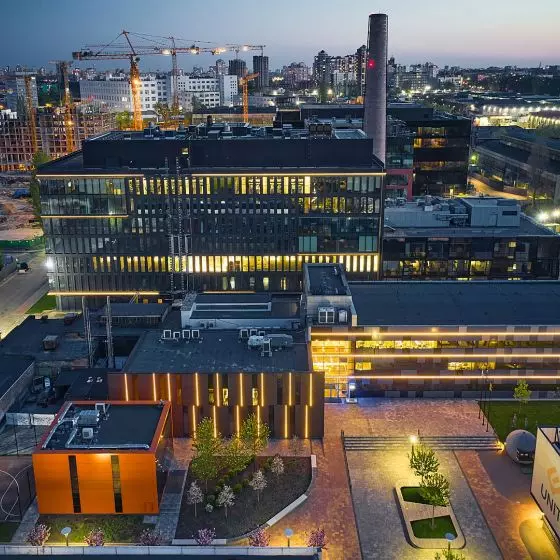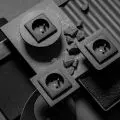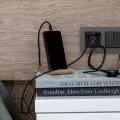TheWave complex, consisting of two independent buildings, is being developed in Gdansk's Oliwa district. It is here that the largest number of investments of metropolitan importance are currently under construction - the place is supposed to act as a catalyst for the development of Gdansk's city center. The newly constructed Wave office building of the medusa group project fits into these assumptions.
Wave is two independent buildings marked A and B located in the northwestern part of Gdansk. The building is characterized by a rust-colored façade referring to the rhythmic composition of port container depots. Each building consists of fourteen floors above ground, and the development provides a total of 48,000 square meters of usable space. The complex offers prestigious offices as well as retail and food and beverage establishments on the first floor.
The Wave office building is located in Gdansk's Oliwa area
photo: Juliusz Sokołowski © medusa group
two buildings
Building "A", located on the east side, is already completed and the first tenants have recently moved in. Building "B" on the eastern side is under preparation. The two will be connected by a link on the third and tenth floors. When designing the building, the architects of the medusa group used economical means of expression, creating an original spatial composition. Looking at the complex from above, it forms a letter "H" rotated at a 30-degree angle. Importantly, the office spaces were made in such a way as to ensure a functional and efficient arrangement. The adopted depth of the tracts and the division of the facade create many possibilities of configuration and ways of dividing the space - depending on the needs of the tenant.
The steel façade consists of modular elements of rudimentary color
© medusa group
steel rusty facade
A steel façade made of modular elements of reddish amber color with characteristic vertical divisions was a rational choice for us. It's a clear reference to the simple and functional rhetoric of port container depots, whose cuboid blocks stacked on top of each other create spatial forms. The repetitiveness, modularity and typification effect were enriched by playing with glass divisions that dematerialize the solid. In turn, the public space between the buildings refers to the Baltic coastal landscape, where the shapes of dunes and waves interact," say the medusa group architects.
Glass divisions add variety to the modularity of the facades
© medusa group
the only such office building in gdansk
The goal of the project, whose investor is Skanska, is to create a modern and functional center offering flexible spaces for comfortable office work and more. There is already a dental center and stores in Building A. The building complex is environmentally friendly, which manifests itself in, among other things, low energy consumption, low atmospheric emissions and the use of appropriate, environmentally friendly building materials and technical equipment. Thanks to their use, Wave is able to consume significantly fewer resources. With responsible management and conscious use of the facility by tenants, water savings thanks to special fixtures can exceed forty percent. The building can also use more than 30 percent less electricity.
The office building has received numerous certificates
photo: Juliusz Sokolowski © medusa group
international certificates and anti-smog concrete
Wave has received the prestigious LEED Core&Shell international certification at the Platinum level. This certification addresses energy savings, water consumption reduction or carbon dioxide emissions. Wave uses electricity from renewable sources, primarily hydroelectric power plants. There is also an anti-smog green concrete sidewalk next to the building. The sun's rays cause a reduction in harmful compounds found in polluted urban air on its surface. This is the first such sidewalk in the Tri-City powered entirely by renewable energy.
Wave, is also the first office building in Gdansk to apply for WELL certification, placing great emphasis on proper ventilation and filtration of indoor air, maintaining proper humidity and thermal comfort. An important aspect is also access to daylight and adequate lighting that harmonizes with the biological rhythm of humans. According to the WELL concept, the office space is supposed to be friendly and allow efficient work without feeling overtired.

































